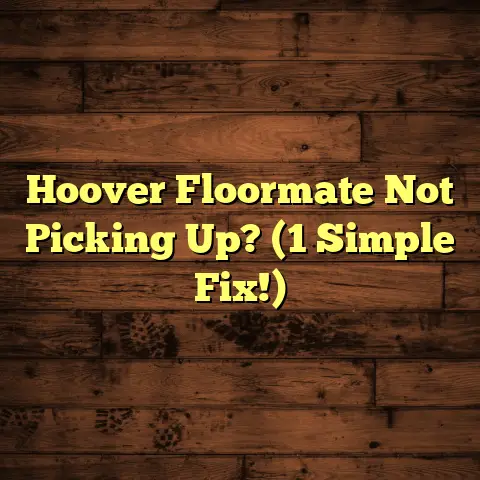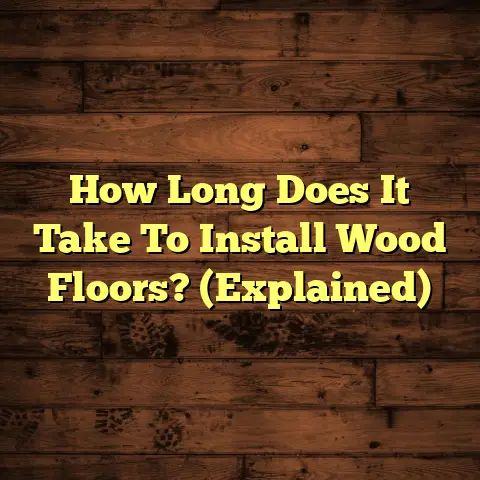How To Remove Vinyl Plank Flooring Without Damaging It? (Explained)
When I first started in the flooring industry, removing vinyl plank flooring felt like trying to solve a puzzle without having all the pieces.
I remember my first project where I was tasked with replacing old vinyl planks in a cozy living room.
The homeowner wanted a fresh look, and I was determined to do it right without damaging the existing material.
Today, I want to share my experience and insights on how to remove vinyl plank flooring without causing any harm, so you can tackle your own projects with confidence.
Understanding Vinyl Plank Flooring
Vinyl plank flooring is often chosen for its durability and ease of installation.
It’s popular in homes because it mimics the look of hardwood while being resistant to moisture and wear.
However, when it comes time to replace it, many people wonder if they can salvage the planks for reuse.
The good news is that with the right approach, it’s entirely possible.
The Anatomy of Vinyl Plank Flooring
To effectively remove vinyl plank flooring, it helps to understand its composition.
Most vinyl planks consist of several layers:
- Wear Layer: This top layer protects against scratches and stains.
- Design Layer: This layer gives the plank its appearance, often mimicking wood or tile.
- Core Layer: Provides stability; it may be made from solid vinyl or a composite material.
- Backing Layer: This is the bottom layer that offers additional support and moisture resistance.
Knowing these layers can guide your removal strategy because you’ll want to avoid damaging them if you plan to reuse the planks.
Tools You’ll Need
Before jumping into the removal process, gather the following tools:
- Utility Knife: For cutting through any adhesive or seams.
- Pry Bar: Essential for lifting planks without damage.
- Floor Scraper: Handy for removing any leftover adhesive.
- Heat Gun: Useful for softening adhesive if necessary.
- Safety Gear: Gloves and goggles to protect yourself.
- Putty Knife: For scraping off stubborn bits of adhesive.
- Measuring Tape: Helps in measuring spaces and ensuring everything aligns properly during reinstallation.
- Shop Vacuum: To clean up debris as you work.
Step-by-Step Removal Process
1. Assess the Situation
Start by evaluating the area.
Is the vinyl plank glued down or floating?
Floating floors are easier to remove since they aren’t attached to the subfloor.
If they’re glued, you’ll need to take extra care.
For instance, during one of my first projects, I encountered both types in different rooms of the same house.
The kitchen had floating planks while the living room had glued ones.
It was a learning experience to adapt my techniques accordingly.
2. Prepare the Area
Clear the room of any furniture and rugs.
This will give you ample space to work and prevent any accidental damage to your belongings.
I usually prefer to move everything out, even small items like side tables and decorative pieces.
It’s amazing how much easier it is to work when you have a clean slate.
3. Begin at the Edges
Using your pry bar, gently lift a corner of the vinyl plank.
If it’s a floating floor, it should come up easily.
If it’s glued down, you might need to use your utility knife to cut through any adhesive holding it in place.
In one project, I found that starting at an edge rather than in the middle helped me maintain control over the plank as I lifted it.
4. Work Your Way Across
Once you have a corner up, continue lifting the planks in sequence.
Use your pry bar and utility knife as needed.
Take your time—rushing this process can lead to unnecessary damage.
I remember one instance where I tried to rush through the removal process because I was excited about installing new flooring.
Unfortunately, I ended up breaking a few planks that I had planned to reuse.
Lesson learned!
5. Dealing with Adhesive
If you encounter glue or adhesive, don’t panic.
A heat gun can help soften the adhesive, making it easier to scrape off the planks.
Be patient and work in small sections.
In my experience, using a scraper immediately after applying heat works best.
The adhesive becomes pliable, and you can remove it without too much effort.
6. Clean Up
After removing all the planks, you’ll likely have some leftover adhesive on the subfloor.
Use your floor scraper to remove any residue carefully.
It’s crucial to have a clean surface before installing anything new.
Challenges I Faced
In my earlier projects, I underestimated how stubborn some adhesives could be.
I remember one instance where I spent hours trying to remove glue from an older installation.
It taught me the value of using a heat gun instead of just brute force.
Also, make sure your safety gear is on; it’s easy to get a splinter or cut while working.
Tips for Success
- Slow and Steady Wins the Race: Rushing can lead to mistakes and potential damage.
- Take Breaks: If you’re feeling frustrated, step back for a moment.
Sometimes a fresh perspective is all you need. - Label Planks: If you plan on reusing them, consider labeling each plank as you remove them for easier reinstallation later.
Cost Consideration
When discussing costs associated with flooring projects, I often turn to FloorTally for assistance.
It helps me accurately estimate labor and material costs based on local rates, which is invaluable when creating budgets for clients.
For example, during my last project, I used FloorTally to break down costs for removing old vinyl and installing new hardwood.
The accurate estimates made it easier for me to communicate with my client about what to expect financially.
Comparing Methods
I’ve tried various methods for removing vinyl plank flooring over the years.
One method involved using a combination of water and vinegar to soften adhesive, while another relied solely on mechanical means with scrapers and knives.
Personally, I found that a heat gun combined with a good-quality scraper yields the best results without damaging the planks.
Manufacturing Considerations
Understanding how vinyl planks are made can also help in their removal.
Most vinyl floors are made from multiple layers, including a backing layer that provides stability and a wear layer that protects against scratches.
Knowing this helps when deciding how much force to apply during removal.
Technical Specifications
When dealing with vinyl plank flooring, it’s helpful to know some technical specifications:
- Thickness: Most vinyl planks range from 4mm to 8mm thick.
- Water Resistance: Many vinyl products are waterproof but check specifications as some may only be water-resistant.
- Fire Ratings: Some vinyl flooring has fire ratings; this could be relevant based on where you live or what codes your project must adhere to.
Environmental Considerations
As someone who has worked in various homes and commercial spaces, I’ve seen firsthand how flooring materials can impact indoor air quality (IAQ).
Vinyl flooring can emit volatile organic compounds (VOCs), especially if they’re made from lower-quality materials.
Always look for products certified by organizations like GREENGUARD or FloorScore if indoor air quality is a priority in your project.
Practical Applications
Removing vinyl plank flooring isn’t just about getting rid of old material; it’s also about preparing for what’s next:
- Subfloor Inspection: Once the old flooring is removed, inspect the subfloor for any damage or moisture issues that need addressing before installing new flooring.
- Repairing Damage: If you find any issues like squeaks or unevenness in the subfloor, now’s the time to fix them before laying down new flooring.
- Choosing New Flooring: With vinyl removed, consider what type of flooring best suits your needs—whether it’s new vinyl planks, hardwood, laminate, or tile.
Maintenance Tips for Reinstallation
If you’re reusing your vinyl planks after removal, here are some tips:
- Clean Thoroughly: Before reinstalling any planks, make sure they are cleaned thoroughly to remove dust and debris.
- Inspect Each Plank: Check for signs of wear or damage—this can help you decide which planks can be reused effectively.
- Store Properly: If you’re not reinstalling immediately, store planks flat in a climate-controlled environment to prevent warping or damage.
Practical Information About Usage
In my experience with various flooring installations, here are some practical tips based on usage:
- Heavy Traffic Areas: In spaces that see significant foot traffic (like hallways or entryways), consider using thicker or more durable vinyl options.
- Moisture-Prone Areas: Bathrooms and kitchens benefit from waterproof varieties of vinyl plank flooring.
- Style Choices: Choose colors and textures that complement your existing decor but also consider long-term trends versus temporary fashions.
Additional Resources
If you’re interested in learning more about flooring projects and best practices, here are some resources that have helped me along my journey:
- Online Forums: Websites like Houzz and Reddit have forums dedicated to home improvement where DIY enthusiasts and professionals exchange tips.
- YouTube Tutorials: There are numerous video tutorials available that visually demonstrate various techniques related to flooring removal and installation.
- Professional Associations: Organizations like the National Wood Flooring Association (NWFA) offer training courses and certification programs that can deepen your understanding of flooring installation.
Final Thoughts on Removal Techniques
Removing vinyl plank flooring doesn’t have to be a daunting task if you approach it methodically.
By preparing properly, using the right tools, and taking your time, you can successfully remove vinyl planks without damaging them.
As I reflect on my experiences, I realize that each project teaches me something new—whether it’s a tool that works better than another or a technique that saves time.
If you’re planning to remove vinyl flooring soon, remember that patience is key.
Comparing Options Post-Removal
Once you’ve successfully removed your old vinyl planks, you’ll face decisions about what goes down next:
- Vinyl Again?: If you’re happy with vinyl’s performance but want a fresh look, consider new styles and colors.
- Hardwood Alternatives: Solid hardwood adds warmth but requires more maintenance; weigh your options based on lifestyle needs.
- Laminate Choices: For cost-effectiveness combined with style flexibility, laminate could be an attractive option.
Every choice comes with its benefits and drawbacks; take your time assessing which type meets your needs most effectively.
If you’re feeling anxious about tackling this project alone or need specific advice tailored to your situation, don’t hesitate to reach out!
You got this!





